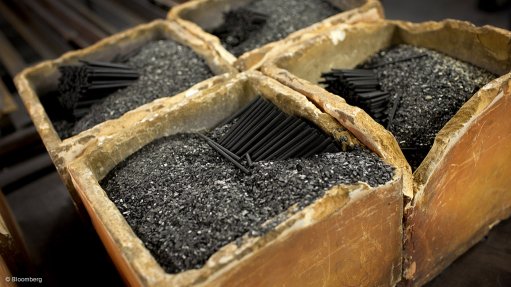
Photo by: Bloomberg
TORONTO (miningweekly.com) – Much of China’s flake graphite production remains offline following a prolonged suspension of operations in many areas owing to severe winter conditions.
Benchmark Mineral Intelligence said on Tuesday while the closures had eased pressure on inventories that had been accumulated throughout 2014, weak demand and the strengthening of the US dollar led to lower prices over recent months.
The London-based research house expected a gradual increase in output towards the end of the current quarter, which threatened to push the market into further excess over the short term, with demand showing few signs of an immediate upturn.
Benchmark expected tighter supply conditions later in the year; however, China was likely to ramp up its consolidation programme as the market moved towards recovery.
“Although industrial demand is unlikely to instigate a recovery in demand in the near term, greater consumption from the battery sector will prevail later in the year as major battery suppliers expand.
“This growth in the emerging hi-tech markets for flake graphite will increase the chances of a supply squeeze, particularly for grades which are also used in existing industrial applications,” Benchmark analyst and MD Simon Moores advised in a note to clients on Monday.
As this unfolded, Benchmark predicted that China’s raw material exports would fall as they developed domestic downstream industries. When the effects of this became apparent, prices were likely to rebound in the latter stages of the year.
CHANGING CHINA
China’s evolution from low-cost raw material supplier to downstream producer would be critical in fuelling a recovery in the flake graphite market, the analyst said.
Last year, a blueprint for the consolidation of the market was laid out leading to the temporary suspension of operations in the Shandong and Heilongjiang provinces and the closure of some of the most inefficient mines in these areas.
Although mines and processing plants had now been given permission to begin production again, weak market conditions saw many reduce output prior to the winter season, with the majority of miners yet to bring capacities back online, Moores added.
As regional governments put further emphasis on the development of value-added industries domestically, demand from these markets would increase and supply availability to the rest of the world would fall.
“If this coincides with greater demand from areas, such as Japan and the US, where significant battery development projects are under way, there could very quickly be a spike in the market.
“With junior projects being slowed by the decline in exploration finance and the few new market entrants, as yet, still incapable of supplying consistent product on a large scale, the market could become increasingly turbulent into 2016,” Moores explained.